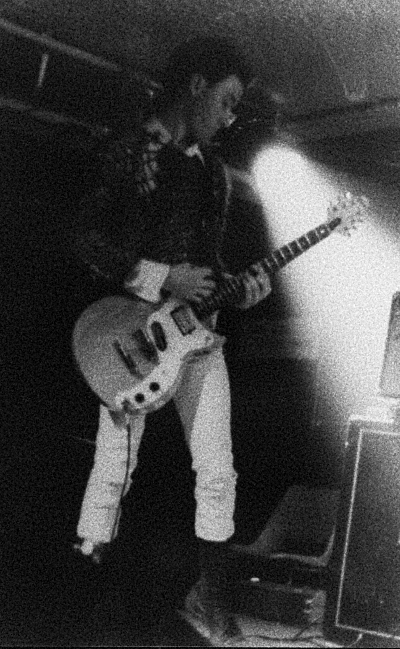 Brisbane music stalwart Rod McLeod died last week after a short and aggressive bout of lung and liver cancer which went to his brain. LCMR Records head, Queensland underground music archivist and friend Donat Tahiraj has penned this remembrance.
Brisbane music stalwart Rod McLeod died last week after a short and aggressive bout of lung and liver cancer which went to his brain. LCMR Records head, Queensland underground music archivist and friend Donat Tahiraj has penned this remembrance.
* * * * *
I first met Rod McLeod sometime in the 1990s when record fairs in Brisbane happened only quarterly. It was a time when vinyl records weren’t exactly in the front of many music listener’s minds.
The occasion was in the sheds of the Mt Gravatt showgrounds. My fellow record-collecting friend Mick Baker and I had noticed a man wearing a seemingly homemade t-shirt with a white iron-on transfer among a sea of people.
Upon closer inspection, he was holding a small handful of 7” singles which, prior to the explosion of eBay, were only obtainable by chance or through want lists. Facing towards our line of sight was one by the Bodysnatchers – a Brisbane punk band that played one show in 1979 and happened to release a record that same year. Its cover with the band’s name done in spray paint in white on a black background was in fact inspired by the “Neu! ’75” shirt that Rod had thrown on that Saturday morning.
Any outward displays of affection for Krautrock in Brisbane was quite a rare sight (much like a Bodysnatchers 45) and so once the ropes of shyness were cut, a conversation between us and Rod ensued.
After the immediate compliment about his chest covering was out of the way, the more important query was raised – why was this guy milling around the stalls by the entryway with these 45s under his arm? Without any direct quotes, it turns out he’s waiting for a visiting collector from Japan who’s offering a few hundred dollars for some punk records he played on. Rod’s telling us this with a great sense of laughter in his voice but Bakes and I aren’t quite getting the joke. Many years later, Rod would proudly gloat that some of the records he was involved with were changing hands for thousands!
First and foremost, Rod McLeod was a record collector. A collection that started with “Band on the Run” by Paul McCartney and Wings, thanks to the Record Market at Garden City which was not too far away from the family home in Macgregor, and would quickly develop into what was then tagged as heavy metal – those early albums by American bands like KISS, Aerosmith and Blue Oyster Cult, which of course were a stark contrast to the safe, readily available choices such as the heavy boogie from the likes of Status Quo on the other side of the Atlantic.
The punk rock explosion was still a few years away so glam and art rock were good corners of popular music to enjoy in the meantime. Bowie. Gary. Roxy. Eno. Reed. SAHB. Mott. These artists were never shy in dropping names in their interviews which were read from sea mail copies of the NME, Melody Maker and local rags like RAM, and the attentive Rod would find his way to Scott Walker through Bowie, Krautrock through Eno and so on.
So when it did make its way to the family home in Fleetwood St in the outer southern suburbs of Brisbane, Rod and his two younger brothers Gav and Clay began to feverishly buy up from the import record stores in the city they’d religiously visit every weekend.
Somehow thinking they’d live together forever, Rod’s main focus was on English punk while second oldest brother Gav would take on the sounds coming from America and the bits and pieces in between were shared with Clay.
When the McLeod family visited the US in 1978, they’d just missed the last Sex Pistols gig in San Francisco by a couple of weeks. With recommendations of record shops and discard warehouses to visit by the likes of the well-travelled Steve Kunde from Rotten Records, Rod was most pleased to find a sealed copy of Television’s first single, “Little Johnny Jewel”. And as far as I know, it’s stayed that way.
As it’s well understood, Brisbane was a very small place, and the number of teenagers interested in music outside of “Countdown” was smaller still. By 1977, punk bands like the Disposable Fits, the Same 13 and the Leftovers had begun playing around hired halls and university campuses, mixing original material with garage rock covers. Pub gigs at that time were still a year or so away.
Enthusiastic young men from the Corinda/Oxley area, Peter Miller and Wolf Kuepper, began a zine named The Rat, covering the local goings on in the new wave scene while grabbing bits of correspondence from abroad - all carefully cut and pasted together and xeroxed. Miller worked part-time at “Discreet Records” in one of the city’s many arcades where the McLeod brothers would frequent and of course pick up some reading material as well.
The Rat managed to fuse punk fans from all corners of the suburbs and soon Rod became one of its contributors, while getting to know Miller and others who he’d found along the way like fellow Grammar student Robbie Lewis, and David Holliday – one of the first to write a letter to the zine.
The four of them found themselves in a band: Rod was on second guitar and grabbed his brother Gav to play bass. Robbie also was on guitar. David assumed drumming duties while Miller sang. Miller had previous band experience in the Sex Haters + Sex, while Rod and Gav had slowly began playing together with fellow Macgregor High student and drummer, John Hunter as the Bodysnatchers.
This new Brisbane band began rehearsing in a shed in Woolloongabba – where Jack McLeod ran a signwriting business called Mack Signs with his three young boys as future apprentices. Having thrown around names like Silent Noise and Urbain Panique (inspired by the breathtaking, ground-breaking French punk band Métal Urbain and their song “Panik”), one of the five suggested – “what about just Urbain?” And so Just Urbain were born.
It wasn’t long before Clay too wanted to be in a band, so Rod assumed bass duties in JU, sharing the instrument with Gav as he formed the Young Identities with the 15-year-old eager to grab a microphone and sneer a bit of anger and frustration - just like Warren Lamond of the Leftovers.
We’re in 1978 and suddenly Brisbane begins to truly respond to punk as the less than half a dozen bands representing the genre during the previous year doubles and triples as the months roll on. Publicans began taking chances on these bands bringing in drinking punters with the help of David Darling and Peter Williamson from 4ZZZ.
As Just Urbain were getting self-written songs together around Rod’s melodic bass lines, they were not terribly keen to play live as guitarist Robbie Lewis pointed out, “we just preferred to play with our friends while we’re practicing.” However, the band did want to record as the lyrics to “Handlebars” - “it was it easy, it was cheap go and do it!” - by the English punk band, the Desperate Bicycles were difficult to ignore. Though in order to get into the studio to record, a few obstacles stood in their path.
Independent recording studios around Brisbane were few and far between and were mostly tied in with church groups who’d use them for putting out various Christian records that (to this very day) help fill the shelves of op-shops.
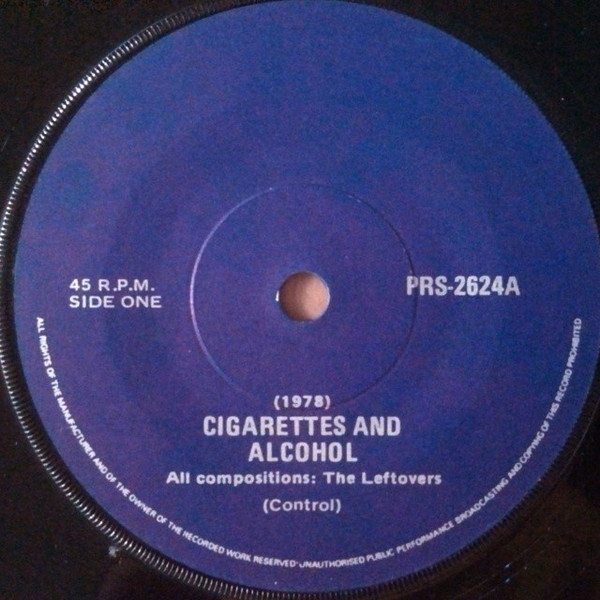
One such studio, connected with the Baptist church, was Multi-Media where the first punk recordings in Brisbane were laid down in 1977 with two songs: “No Complaints” and “I Only Panic When There’s Nothing to Do” by the Leftovers through a state-of-the-art NEVE desk and 16-track tape recorder. Perky (Tex Perkins’s older brother Rob) helped fund this venture while the band were some months old and were struggling to hold down a steady line up. The recordings were shopped around and even Mushroom Records seemed interested at one point (but that’s entirely another story for another time.)
Despite the Leftovers having a reputation of being dysfunctional, chaotic and most of all: unapproachable, the members of Just Urbain were besotted with them. Although they had two songs already recorded and no release, independent or otherwise ,forthcoming, the Leftovers returned to Multi-Media in the middle of ‘78 and record a further two more tracks: “Cigarettes & Alcohol” and “Hermine”. With the band’s early manager and mentor Perky disappearing to Darwin, Rod and the band decide to pick up invoice that was made up of many hours of guitar, saxophone and piano overdubs.
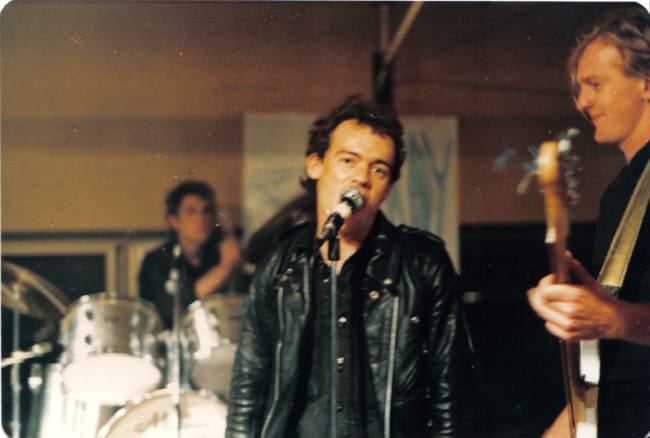 The Leftovers live at Griffith Uni.
The Leftovers live at Griffith Uni.
“We didn’t want to put out a record before the Leftovers did,” is what drummer David Holliday has said to me countless times, and that’s the sort of high reverence we’re talking about here. The only way to fast track a release by the then-known Fucken Leftovers was to pay for its pressing too. For example, Rod had made money through his work as a signwriter. While he would’ve preferred to have gone to art school and become a painter, Jack had better ideas for his eldest. And while dad wasn’t looking, Mack Signs and their screen-printing gear inside the factory, would certainly come to good use as the ‘70s became the ‘80s.
It’s June of 1979 and the Fucken Leftovers finally have a seven-inch single out with their name missing from the label – your only clue of who the record is by was from reading the songwriting credits. Five-hundred were pressed. Rod took a few, 25 count boxes to Sydney and Melbourne to distribute around the record shops.
To allow a bit of contrast, the band’s bassist Glen Smith and his brother Gary used their assigned copies as clay pigeons to fire shots at, while drummer Ed Wreckage threw his off the Indooroopilly Bridge and into the brown snake.
It’s the time to record and release a record. The ‘70s are about to come to a close and now the Fucken Leftovers join the Survivors, Razar, the Go-Betweens and the Riptides (née the Numbers) as bands who’ve responded to punk and put out their own records. It’s Just Urbain’s turn. It’s the Young Identities’ turn.
Col Rankin from Skinny’s Records has a jingle studio near his shop and the two bands (along with the Bodysnatchers) lay down a batch of tracks for two EPs and a single in a day – a simple task when they’ve spent over a year playing in workshops and garages.
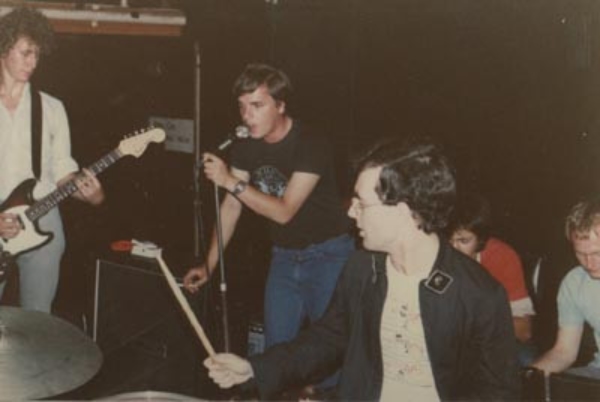
Just Urbaine.
With three master tapes finally made, they arrive in August at EMI’s Custom division in Sydney. One of the cutting engineers has an issue about the discordant noise rolling through the tape heads of the Just Urbain songs. Peter Miller gets a 10” acetate in the mail and informs the concerned over the phone with, “this is exactly what we want it to sound like!”
The sleeveless records arrive in Brisbane in October, around the same time as the Apartments get their records from EMI Custom. Suddenly there’s momentum in Brisbane!
Knowing full well that their audience is close to non-existent at this stage and having not formally played live, they request a pressing of 100 copies. Miller and David Holliday put the artwork together with the help of a photocopier, cutting and pasting from found art.
The Young Identities’ EP is sleeve is drawn by Rod where he’s credited on the back as “tunes, manipulation” and is screen-printed on five different colours of card paper at Mack Signs. 300 in total were pressed up. If you wrote to the McLeod family house in Fleetwood St, you could get some shirts and badges they’d made. The brothers made good use of the work facilities as they’d print up their own Adam & the Ants or New York Dolls shirts and swap them for records at Rocking Horse and elsewhere.
Now we go right back to the beginning with the Bodysnatchers and 300 were pressed with photocopied covers leaving behind many empty black toner cartridges.
These three releases make up the Savage Music label. While all involved displayed a great amount of enthusiasm towards releasing their own music, each sank without a trace. A fourth release was planned: a compilation album featuring the three SM bands along with the Missionaries of Death, the Leftovers and the Grudge but sadly it never eventuated.
A student named Murray Bent organised a multimedia show called “Ready, Steady, Go…” at Griffith University in November 1979 where the Just Urbain, the Young Identities and Bodysnatchers appear live and in public for the first time. Joining them that night was a surprise appearance by the Leftovers, playing their last ever show and featuring early guitarist Jim Shoebridge who’d been out of the band for more than a year – apparently booted out for bringing his mum along to a practice.
Bent had at that time had written a zine called My Body, My Records and had made film clips for bands. One of those was for the Bodysnatchers but it’s yet to surface. More research from the writer is clearly needed (unless the reader finds a way to get to it first.)
It’s 1980 and Rod’s already taken part in releasing four records in the short time of six months. Clay’s too young to be playing in licensed venues but it didn’t stop him and the Young Identities from gatecrashing Fun Things shows. It’s an era when Brisbane’s alive with numerous inner-city venues thanks to promoters like David Darling and John Reid. Suddenly we had the Silver Dollar, Pinocchio’s and Rocky’s to name but three.
Darling booked shows at the Silver Dollar for most nights of the week and over the course of around nine months had put on around 60 punk/new wave-friendly shows – no mean feat. Rod would often mention how the complimentary spaghetti meal (to comply with liquor licensing laws) would get tossed around the room nestled under the Focal Point Arcade in the Valley.
Using the name “Brisbane Devotee” in the University of Queensland rag Semper, Reid wrote that he saw strong parallels between the Purple Hearts and Razar (who he managed). He labelled Young Identities “a decadence band” with money from day jobs to support their “uncared for’ music” and wondered if they were simply “martyrs for art or morons with money?”. He was far more nurturing and supportive of Rod and his bands, and gave Just Urbain and the Young Identities a venue to play – if they actually wanted to.
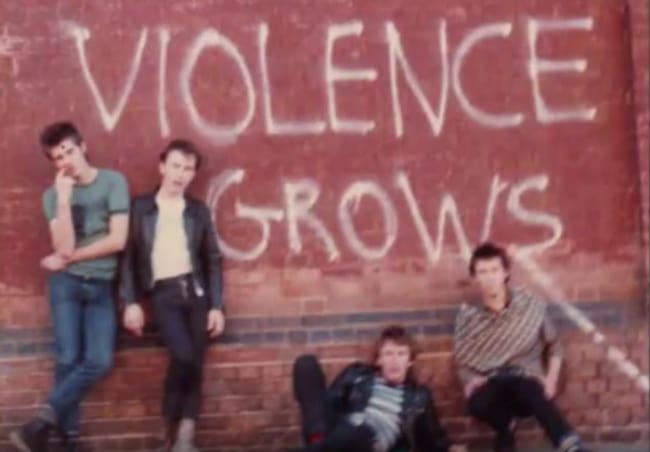 Young Identities.
Young Identities.
In an article for the fanzine X-Change, Rod reflected in issue #5 from 1983 how the band only played when the urge arose, and that he and his bandmates were “fortunately avoiding the two diseases that plague Brisbane bands – overexposure and becoming laboured.”
During the start of 1980, guitarist Dave Robinson leaves the Young Identities and Rod joins, armed with his Gibson Marauder and Cuban-heeled boots. The three McLeod boys are now together in one band.
Despite the fact that Savage Music’s back catalogue did nothing locally or further afield, it didn’t seem to stop either Just Urbain or the Young Identities from recording once more. As the “Brisbane Devotee” pointed out, these working class lads from the outer suburbs “had money to burn”. This time it’s at Forest Glen Studios, in the heart of the Sunshine Coast where the Fun Things had recorded their EP in February. Engineer Mungo Coats managed to successfully capture the “full scale attack” of the band and thus a roadtrip was set up.
This is a part of the local music timeline where most of the ’78 bands who played ’77 punk had imploded and the Young Identities were among the last standing and still playing three chord thrash but that was soon about to change after some unfinished business.
This time 500 copies of the “New Trends” EP were made at EMI Custom, again it’s adorned with Rod’s artwork – a fluorescent blood orange linocut over black ink. Despite the seemingly large amount pressed, only a handful of the covers were screen-printed, as by the time the record came out, the band were about to transform into an entirely different entity. 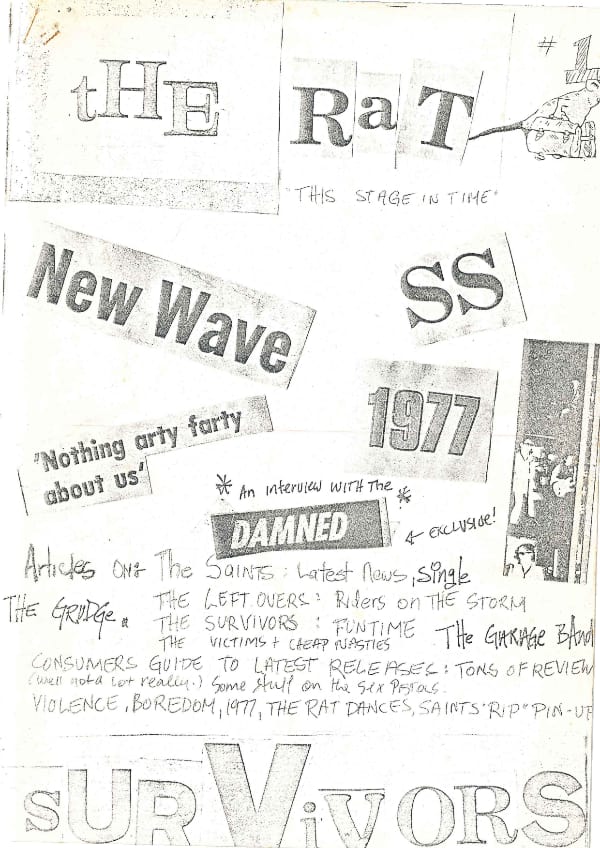
Just Urbain’s “Everybody Loves Just Urbain” was made in a numbered edition of 200 with a sleeve done by Peter Miller and David Holliday with the band moving away from its earlier, more primal and industrial influences if a descriptor is required using brush strokes that are indeed wide.
This pair of releases was the start of a new label, Shakemusic. The name change seemed like a fresh start.
Again, the buying public were not all that interested in their DIY expressionism, and nobody involved had any grandiose ideas of becoming full-time musicians – least of all Rod and his brothers at Mack Signs.
With the year drawing to a close, the Young Identities ceased to exist and Just Urbain’s personnel began slipping out of Brisbane on extended breaks. While the McLeod boys certainly loved the music that helped shape the Young Identities, it became stale - especially around Brisbane. And the city’s response to American hardcore punk was still a couple of years away.
Kicks rose out of the ashes of the Young Identities. Rod said that while he liked the Paul Revere and the Raiders song of the same name, he enjoyed Lou Reed’s one from his 1976 album, “Coney Island Baby”, even more. It was an early addition to his record collection, and an album he held in high esteem throughout his adult life.
In his late teens, Clay’s sneering voice became more of a crooning baritone with an unmistakably Bauhaus influence, a band whose musical sparseness Kicks also embraced while dressing quite similarly to the scarf-wearing Scottish post-punkers, the Scars.
Kicks released “The Secret” b/w “Return of the Action Man”, a double A-sided single at the end of ’81 on the Shakemusic label. They quickly sent off a copy to English label, 4AD who politely explained to the McLeods that they had more than enough bands exploring that style. To their defence, there was an undeniable glam influence, thanks to the Glitter Band, as Kicks eventually recorded and performed live with a two drummer line up.
Like Rod’s other bands, Kicks didn’t play live too many times either, keeping true to his personal philosophy which seemed shared by the rest of the brothers. Despite Darling’s new venue, the 279 Club at the Exchange, being one of the most vibrant venues of 1981 and by far the most receptive to post-punk and indie music in general, Kicks never once played there.
By 1983, it was all but over. Gav and Clay never played music live or in a studio again. That previously mentioned shared bass with Gav (now adorning a sticker hand cut vinyl lettering of KICKS) ended up against a wall in the dining room gathering dust.
Rod sporadically kept playing music with the Chickens from Hell who eventually became the Pineapples from the Dawn of Time. In 1987, they released the “Shocker” LP – one of the strangest and wildest psychedelic pop albums ever. Their story is well known and was how I first heard Rod’s music as 4ZZZ were no strangers to playing their song, “Too Much Acid?” And nor was “Rage” playing their video clip in the '90s.
I didn’t want to set out and start writing Rod’s full biography but I felt like it was necessary to tell the reader where he fit into the scheme of things in Brisbane. He was a part of a group of people that missed seeing the original Saints live – just a little too young and in a completely different world out there in the back streets of Macgregor to know what was happening up and down the Ipswich train line. What he did get to see was the Leftovers in full flight – a local band that was as close to the Sex Pistols as one could get - but even more real as they weren’t a manufactured band.
It was some years after the Leftovers split that Rod and singer Warren Lamond had become the best of mates though a myriad of mutual connections. I was reminded of this strong friendship more times than I’ve heard, “Hey Donnie have you got this record?” coming out of Rod’s mouth with a cigarette hanging from his lip as he was pulling records from his bowing shelves of 45s.
As much as Rod was a hero to many people (myself included), he had his and Lamond was one of them. He would flick on Rod’s old Rhythm Ace drum machine (listen to the start of “Frantic” by the Bodysnatchers – that one!) and use it as background music while he read a book during some of his extended stays. These were one of many stories I’d heard and held into memory, much like all the ones that I’ll keep about Rod. It’s difficult to forget rolling joints for Can’s Damo Suzuki on Rod’s verandah in the wee small hours of the morning or any other encounter in my life with him in it.


